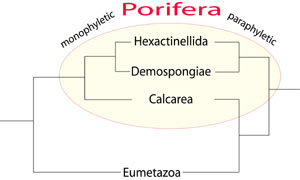Research » Evolution & Phylogeny » Deep Phylogeny
|
|||||
|
 |
||||
All those issues remain highly topical. We are currently applying molecular approaches such as comparative multi-locus DNA sequencing analyses, phylogenomics as well as biomarker analysis and combine those with thorough morphological analyses to contribute to solving these important questions, in collaboration with several national and international partners and initiatives.
Key publications:
Philippe, H., Brinkmann, H., Lavrov, D.V., Littlewood, D.T.J., Manuel, M., Wörheide, G., Baurain, D., 2011. Resolving difficult phylogenetic questions: why more sequences are not enough. PLoS Biology 9, e1000602.
Philippe, H., Derelle, R., Lopez, P., Pick, K.,
Borchiellini, C., Boury-Esnault, N., Vacelet, J., Renard, E.,
Houliston, E., Quéinnec, E., Da Silva, C., Wincker, P., Le Guyader, H.,
Leys, S., Jackson, D.J., Schreiber, F., Erpenbeck, D., Morgenstern, B.,
Wörheide, G., Manuel, M., 2009. Phylogenomics revives traditional views on deep animal relationships. Current Biology 19, 706–712.
Dohrmann, M., Janussen, D., Reitner, J., Collins, A., Wörheide, G., 2008. Phylogeny and evolution of glass sponges (Porifera: Hexactinellida). Systematic Biology 57 (3), 388–405.